Visit Spain, fifth & last stop: Seville
After visits to Barcelona, Valencia, Úbeda & Granada, we ended our journey through Spain with a visit to Seville.
Sevilla – in Spanish – is the capital of Andalusia. Also a city with a long, interesting history, beautiful monuments, amazing architecture & a vibrant local culture. An inspiring city. Ideal for sightseeing, but also a perfect base for some unforgettable outdoor activities. A top destination as you will see & read in this blog post.


- Throughout this post you’ll find affiliated links & ads provided by travel platforms like Tiqets & GetYourGuide. Agencies who – all under one roof – offer tours, tickets & passes for all major attractions in Seville, often combining several things to do for affordable prices.
- The links & ads they provide that may help you plan the perfect trip to Seville. If you click on them & buy a ticket for a museum or book a tour a small commission of your purchase will go to me (paid by the platform, without any extra cost to you).
- If you first want to learn a little bit more about me, the blog writer, click on: Better call me Art
Seville, gateway to the Americas
Seville has a rich history. For centuries, it was the gateway to the Americas. Something you notice right away when you visit the city center of Seville.
First of all, there’s the serene Río Guadalquivir that splits the city in two. The river where most expeditions westwards started & ended.
The Guadalquivir is still watched over by the Torre de Oro. The Golden Tower, where all the riches were stored temporarily when ships arrived from the colonies.
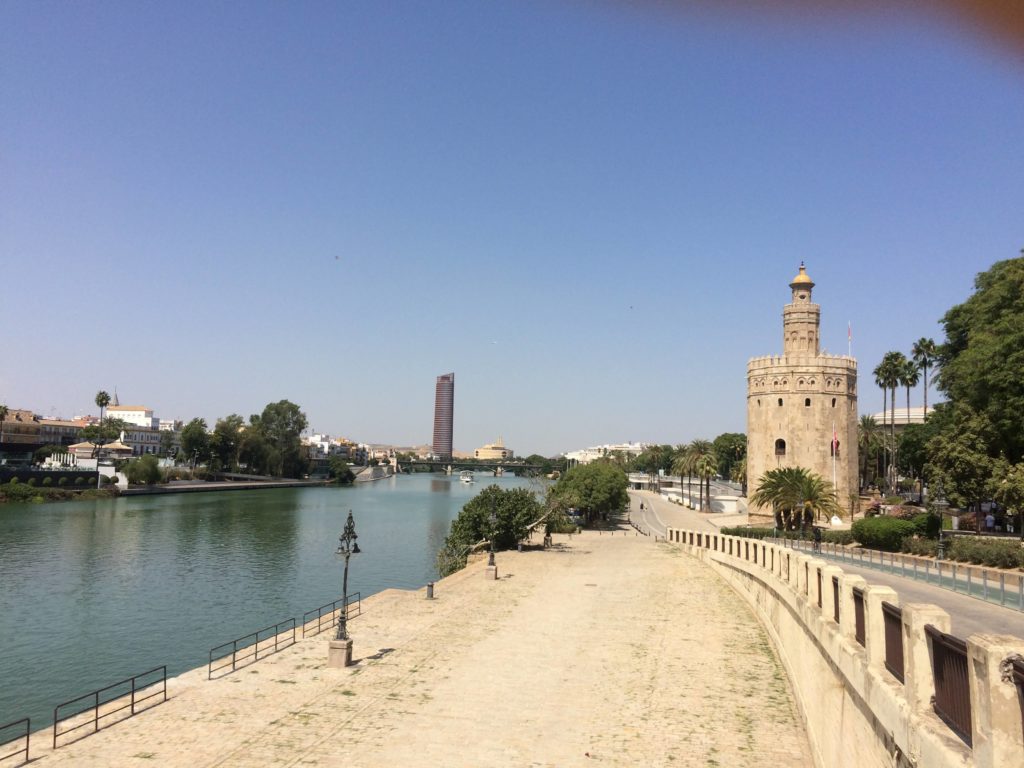
Near the river you’ll still find several beautiful stately mansions. Little castles that were built by the people who got extremely wealthy from the gold, silver & what else that came from New Spain, Peru & the other colonies. A wealth you’ll also observe in the churches & other monuments in the city center.
In the Alcázar of Seville you can still visit the former Casa de Contratación, where the rules of the overseas business of every outgoing expedition were discussed, put on paper, signed & controlled.
And then there is the Archivo de Indias, where all the paperwork concerning the Americas ended up. Millions of letters, contracts, judicial reports, books, maps & much more.
Of course, Seville has much more to offer, but for me personally these historical monuments were extras, living in Latin America half my life.
Catedral de Santa María de la Sede, Seville
One of the biggest attractions of Seville is its enormous gothic Cathedral. Definitely worth a visit. It’s actually one of the biggest churches in the world & World Heritage since 1987.
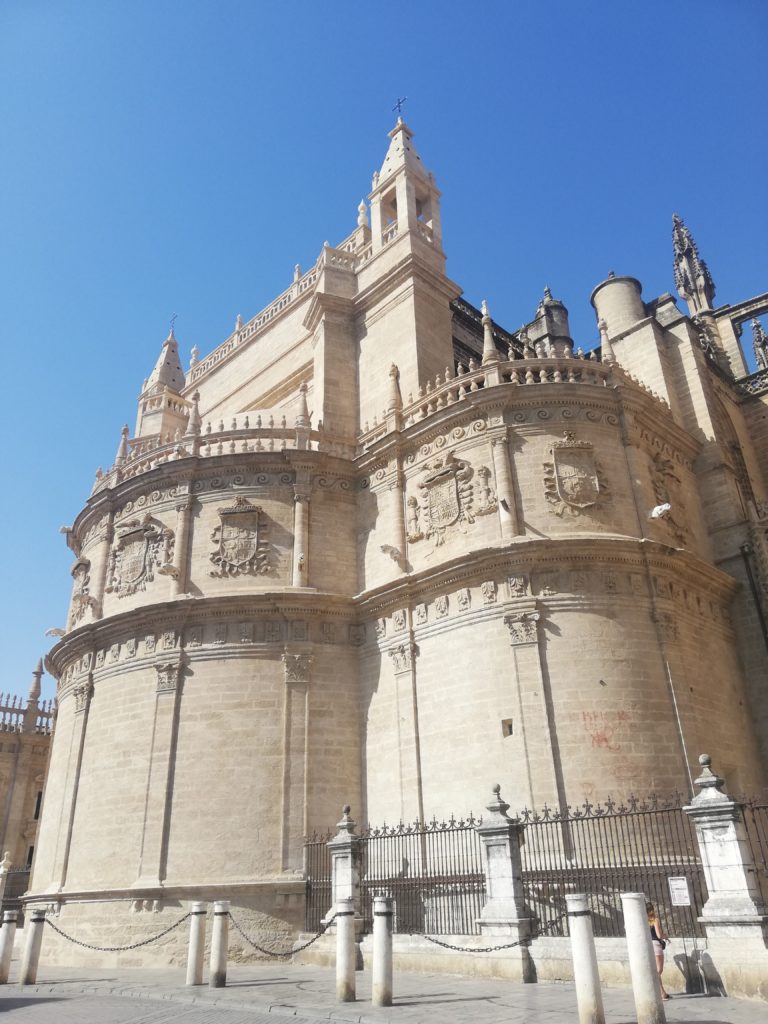
- As with many other churches in Spain, this cathedral is built over a former mosque. Something you don’t really notice, because when the Iberians recaptured Seville in May of 1248 they destroyed the former prayer house almost completely, before building a new one.
- The only thing that remains of the old mosque is its minaret. This tower stands besides the cathedral and is called La Giralda. Just as the cathedral it’s enormous, over 100m/328ft high. Originally it was lower, but the Spanish victors decided to add a bell tower to it, which was more in concordance with the sky-high cathedral.
The first thing we noticed, standing in line for our visit to the Cathedral of Seville, was the fact that we weren’t the only ones. There were rather thousands, instead of hundreds of people visiting the cathedral.
Once inside, you understand why. Its interior is as overwhelming as the cathedral’s exterior! In a literal, as well as in a figurative sense. The Cathedral of Seville is almost too big for us small humans to visit!
Some highlights of the Cathedral of Seville
* One of the highlights for me was the Capilla Mayor, in the middle of the church. The place where most visitors gathered, of which some gave me the impression they would never leave. As if living in that spot.
One of the reasons for their presence though was the enormous quantity of ornaments this altarpiece offers. They are a thousandfold! So, if you are very devoted or just very interested in every detail, I think you can lose your mind right there. Overwhelmingly beautiful really.
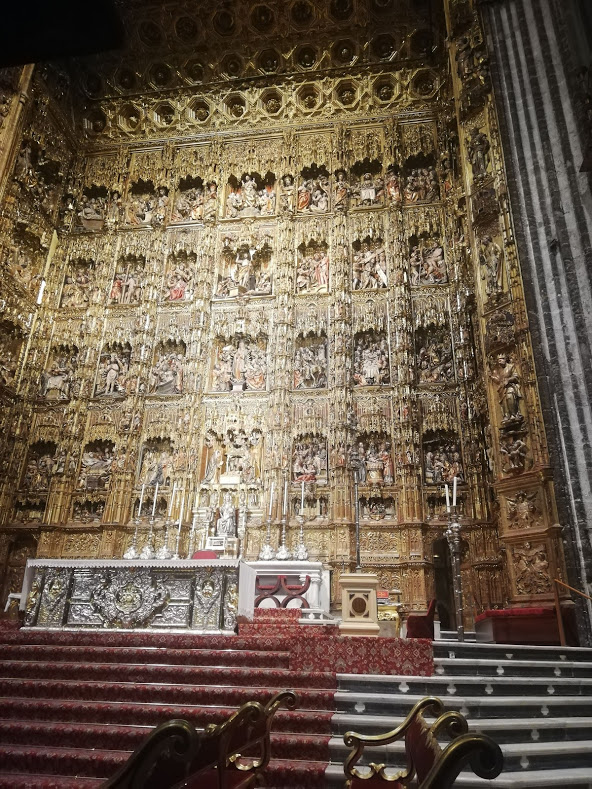
* Another highlight – and for me personally, the absolute highlight – of the cathedral was the tomb of Christopher Columbus.
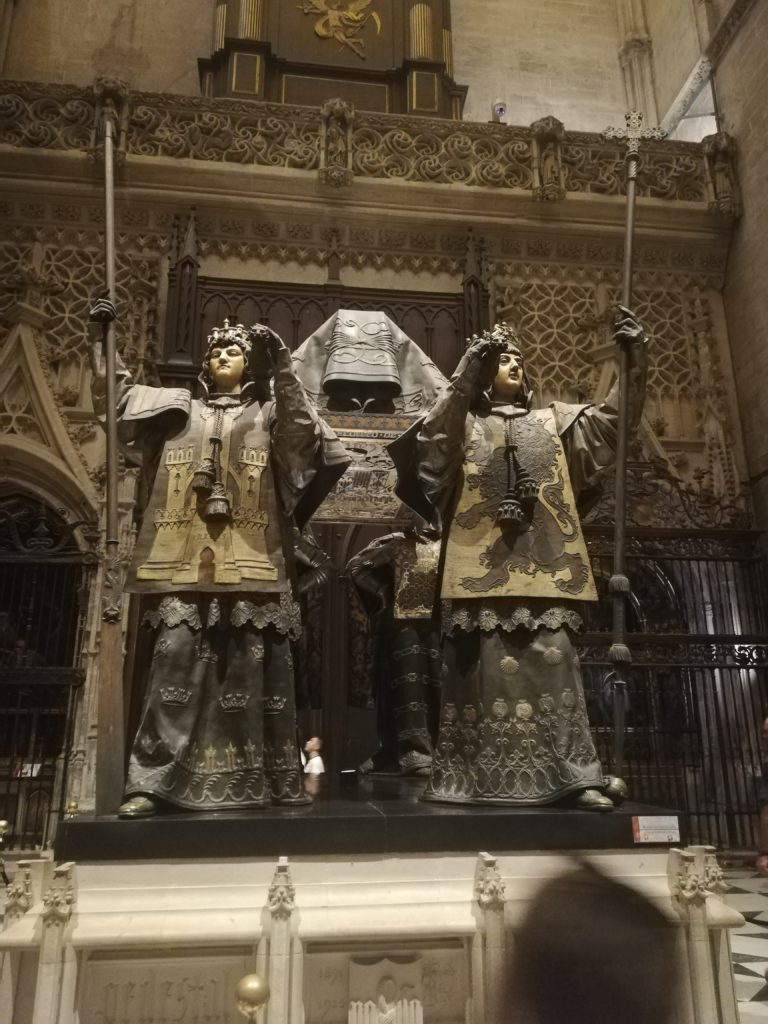
At least, that’s what they say: “The last resting place of Columbus!”
- Until today there intense discussions take place about the remains of Columbus. Besides Seville, Santo Domingo – capital of the Dominican Republic – also claims to be the last resting place of the man who colonised their island for Spain inmediately after his “discovery” of a new continent.
- Although recent DNA tests have shown that Seville is right in claiming Columbus’ remains, this doesn’t mean that some parts of his body couldn’t have ended up in Santo Domingo
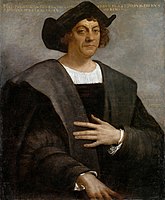
La Giralda tower
After our tour of the cathedral, we climbed the Giralda. Well actually – instead of climbing stairs – we walked up a continuous ramp that leads to the top.
- The muslim rulers placed this ramp in the minaret on purpose, making it possible for horse & rider to go up to the highest level.
It’s a long way up – a little nauseating, to be honest, after our visit to the enormous – but the views from the top over Seville made it absolutely worthwhile. City sightseeing in one place.
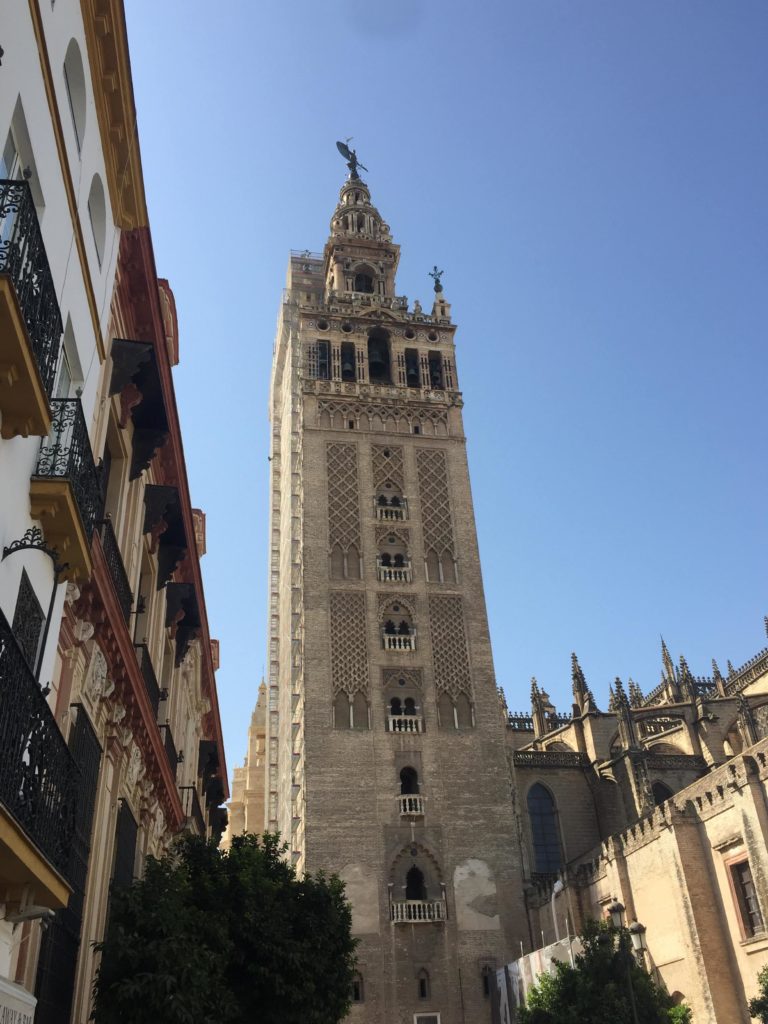
After our conquest of the tower, we – and every other visitor – ended up in the Patio de los Naranjos. Besides a beautiful square full of orange trees, a spot for a well earned & necessary breath of warm, but fresh air. The square originally was built by the muslims, but I said… Amen!
Tickets to the Cathedral
TravelTip: Buy your tickets in advance for the Cathedral
When we were in Seville the high season was just over, but there was still a long line to get in. Not as long as at the Alcázar (see below), but long enough to regret not having bought tickets beforehand.
To learn more, go to:
Alternatively, there’s the option to visit the rooftop of the cathedral on a guided tour:
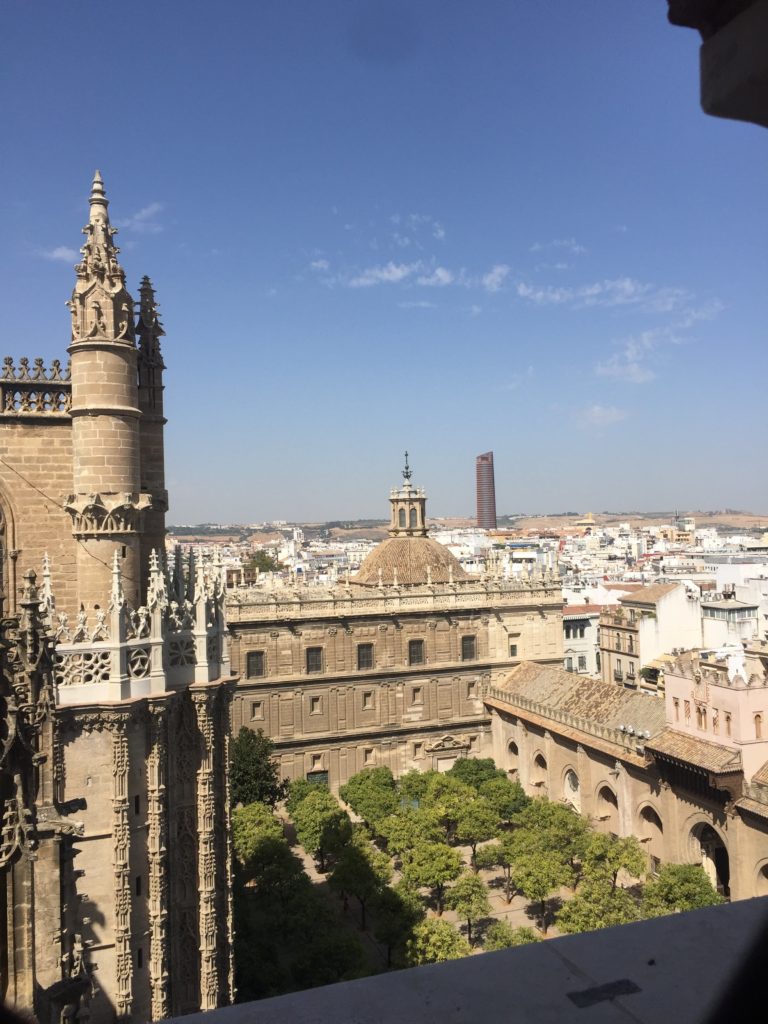

A visit to the Real Alcázar of Seville
Besides the cathedral, another MUST SEE when you visit Seville is the Royal Alcázar. Also blessed with the title of World Heritage site by UNESCO in 1987.
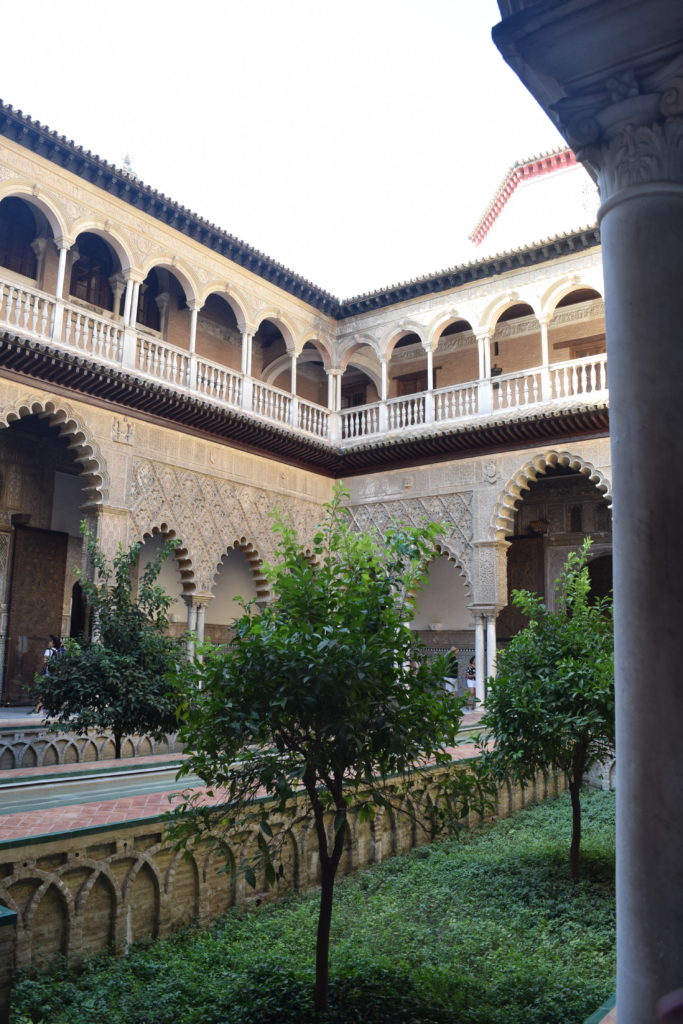
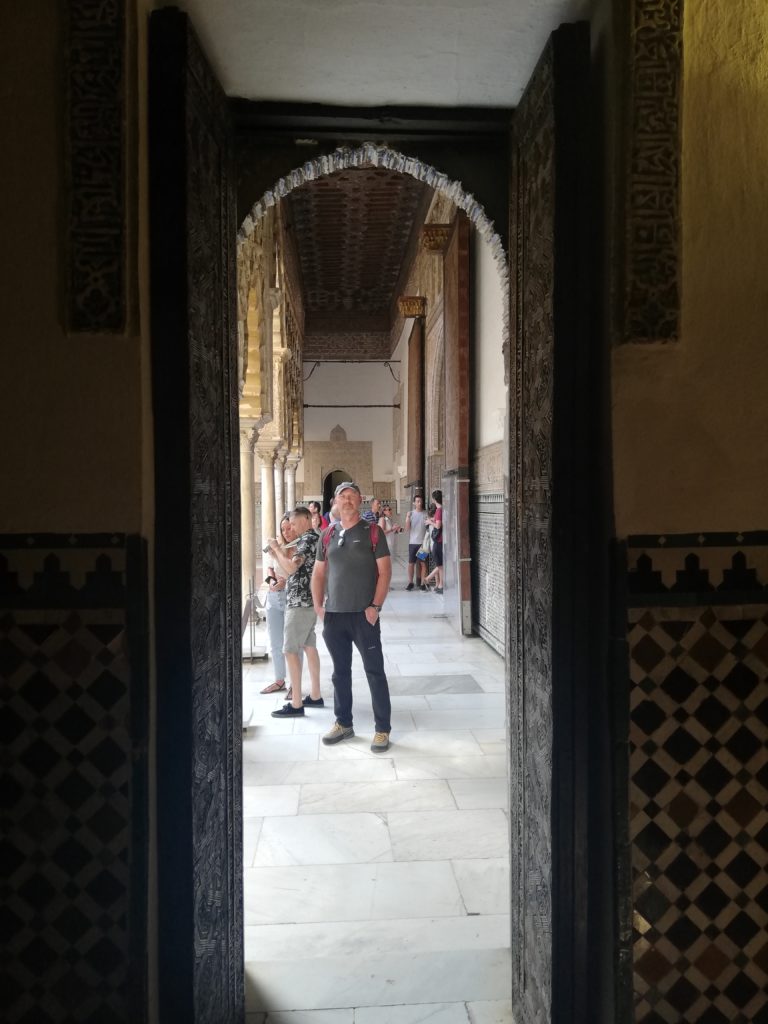
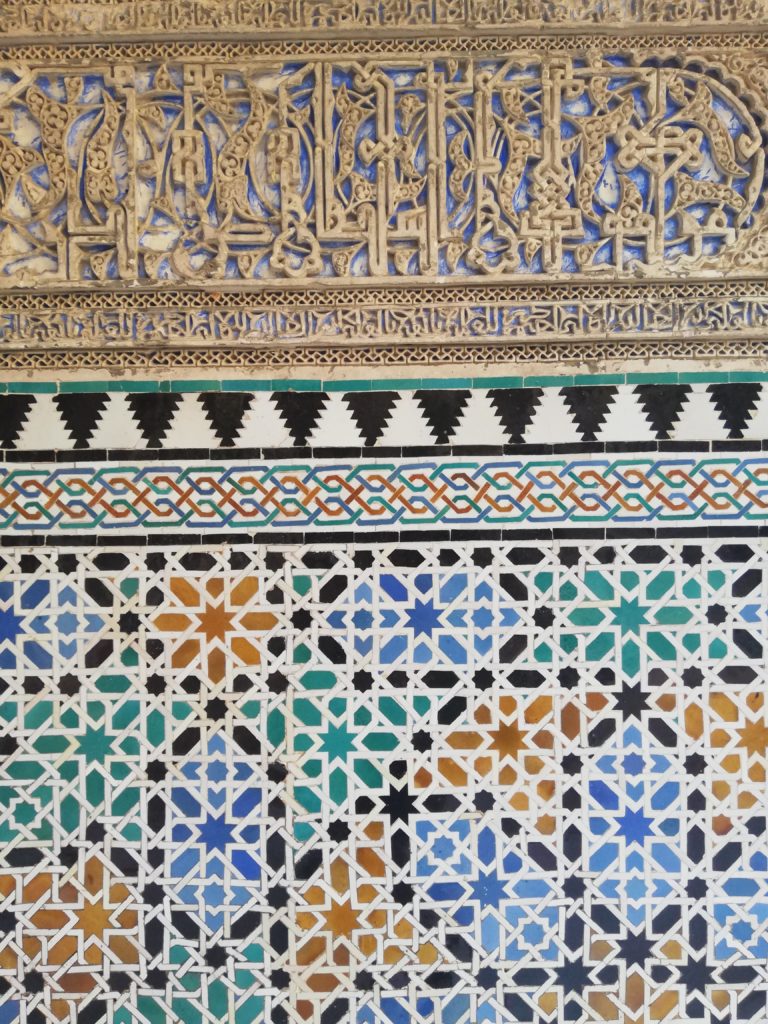
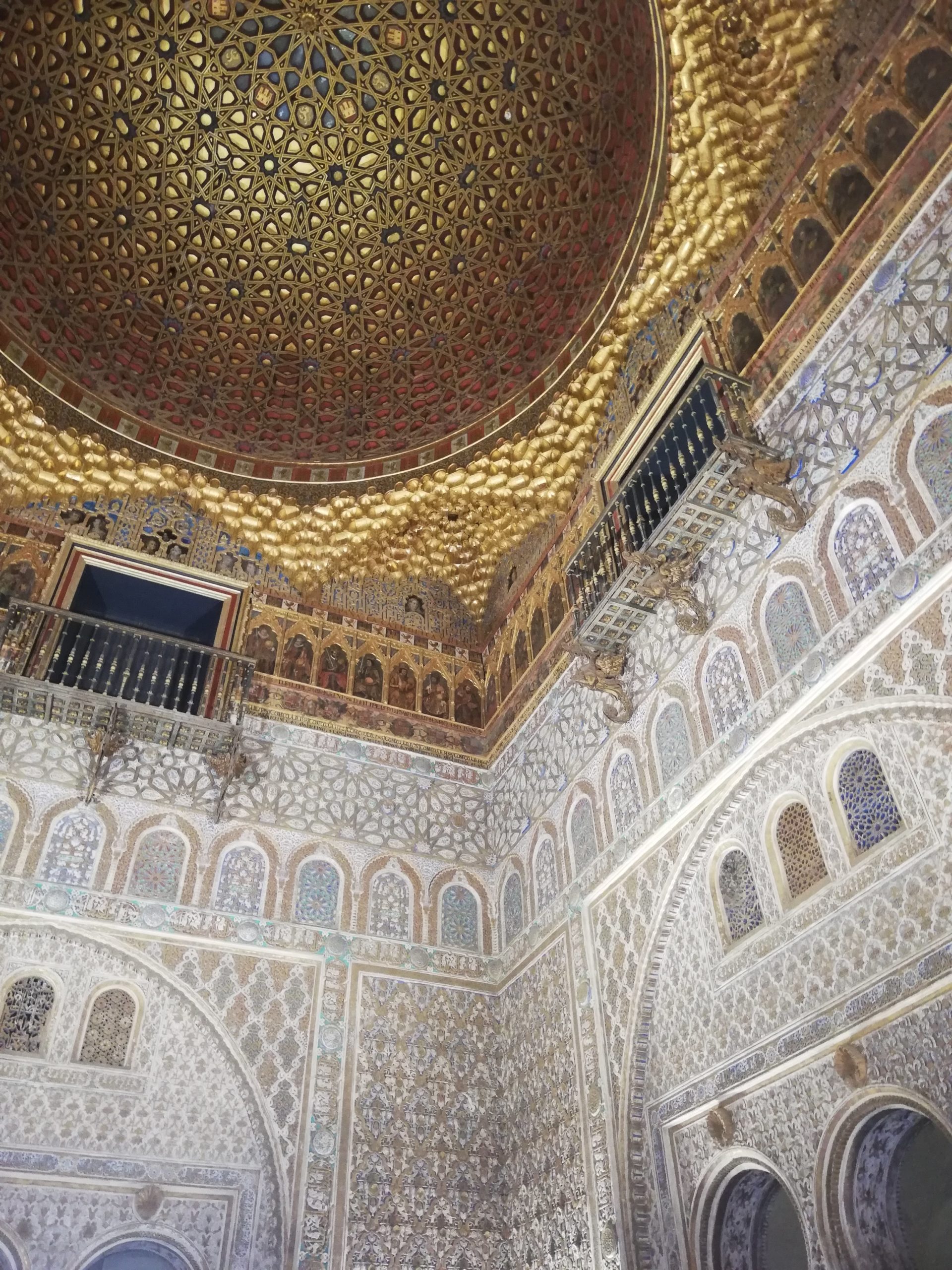
- The Alcázar’s earliest foundations go back to the beginning of the 10th century. The construction was amplified again & again as history took its course through southern Spain.
As with many historical buildings in this part of Spain you can expect a mixture of Muslim & Christian Art styles. A paradise-style Arabic base complemented with sober & often devotedly somber European details. A mixture called Mudéjar.
Soon after passing the entrance gate you enter a big inner courtyard, the Patio del Montería. From this inner square you get your first glimpses of the Alcázar. Glimpses of Royalty.
Seville, starting point for the cross over to the Americas
I personally was very interested in visiting the rooms on the right hand side of this courtyard. Formerly this part of the Alcázar housed the Casa de la Contratación de Indias. The Contracting House of the Indies for many centuries functioned as the main office for control of business & trade with the Americas.
In other words, through these rooms many of the Spanish conquistadores & colonists passed on their way to the overseas colonies, mostly staying there for many years on end & sometimes forever.
- Among them, the country where I am living now for many years, see the Homepage of this blog.
Although these rooms aren’t as impressive as others of the Alcázar, I was imagining men like Columbus, Cortés & the Pizarro brothers walking in & out for a last reunion before crossing the Atlantic to their destinations & destinies.
When finally everything was ready for the journey, they and many of their crew brought a last visit to the Contracting House. Mainly to say a last prayer and ask for protection in front of the Virgin of the Navigators/ Virgen de los Navegantes in its Audience Hall.
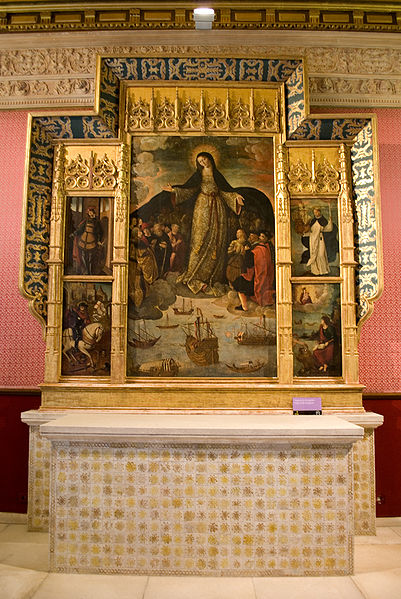
The Palace of Don Pedro I
The Palace of Pedro I is also called the Palacio Mudéjar, and that says it all. Although not as extensive as the Nasrid Palaces of the Alhambra in Granada, this palace is the aesthetic highlight of the Alcázar.
I am not only referring to the inner rooms of this palace, which are amazingly beautiful, but also the open spaces within. Firstly a series of fairytale inner courtyards & secondly an extensive shady park-like garden.
And shadow is what we were looking for every day in the tremendous Summer heat of Seville.
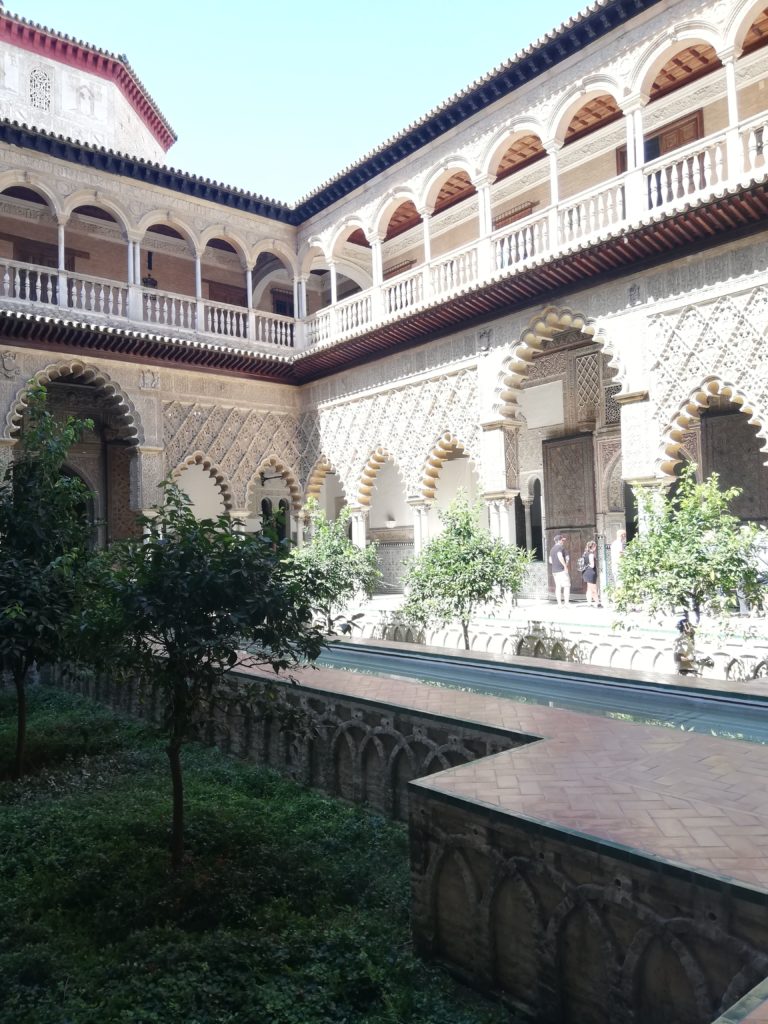
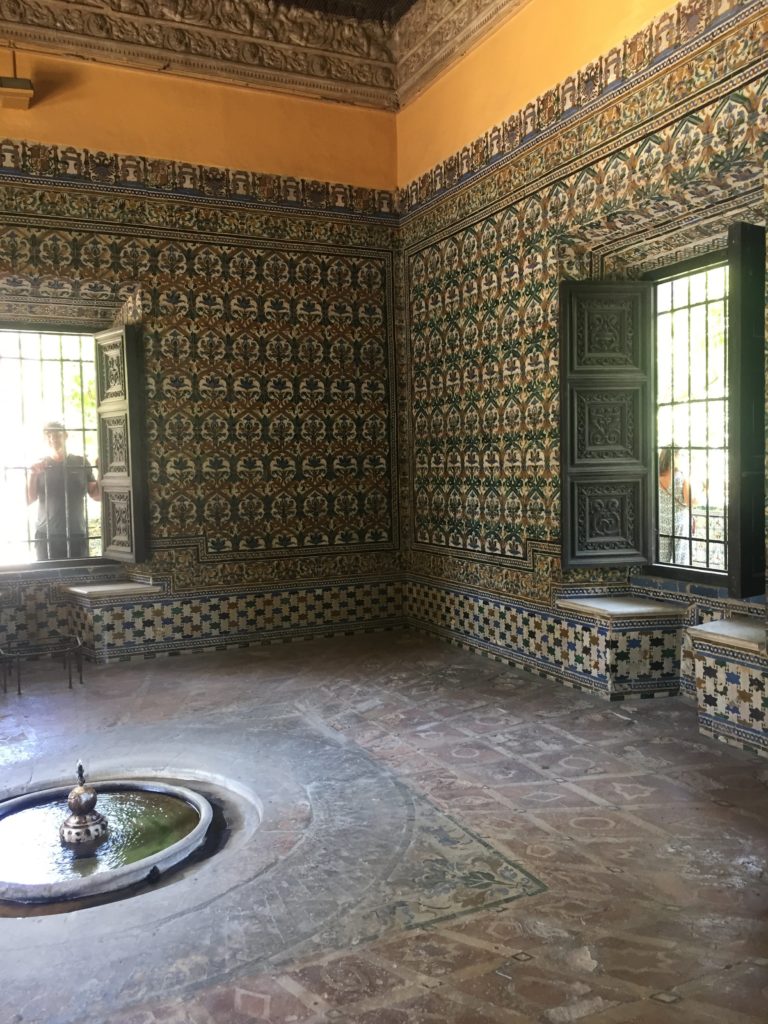
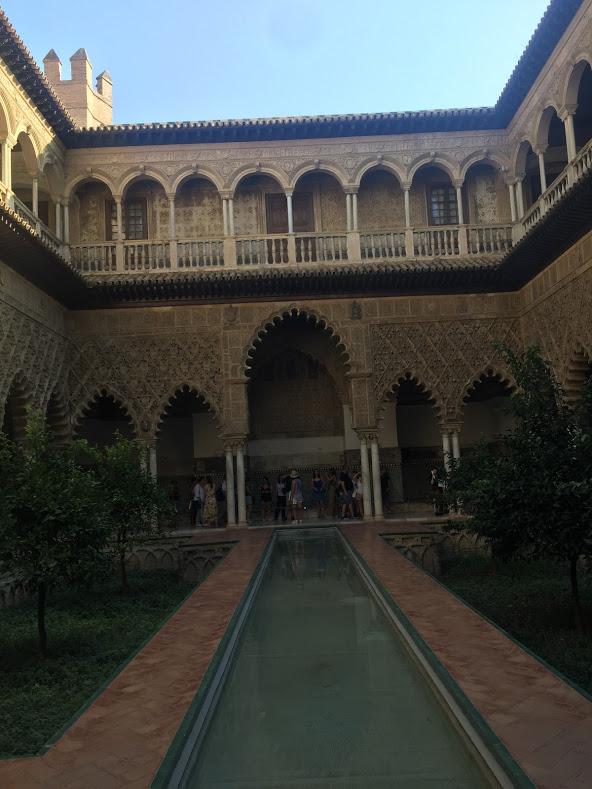
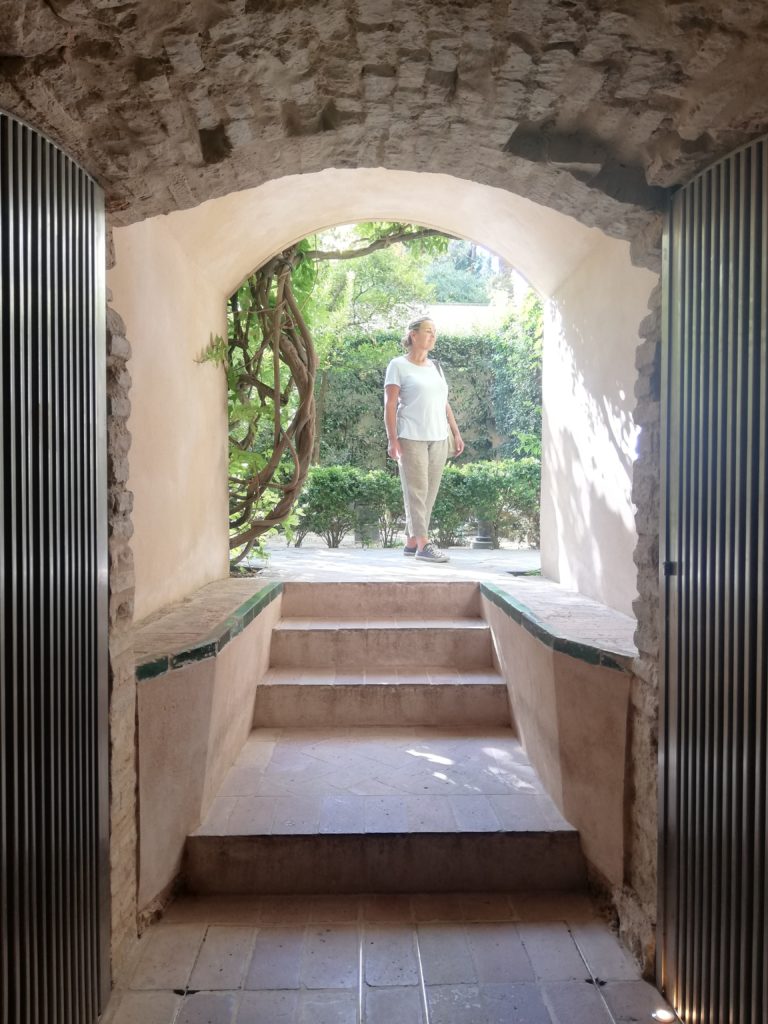
Tickets for the Alcázar of Seville
TravelTip: As for the Cathedral, I highly recommend you to buy your tickets for the Alcázar in advance.
Year round, and certainly during the high season (Summer months + Holidays), long lines form in front of the ticket office. Buy your tickets well in advance, so you can skip the line and – more importantly – avoid being left out.
To learn more, go to:
If you prefer a guided tour, click on:
Alternatively, there’s the option to combine a visit to the Alcázar of Seville with the neighbouring Cathedral:
Or else, the option to buy one of the Seville City Passes (which include other attractions and discounts):

TRAVELTip: Getting around in Seville
As we stayed near the city center, we walked a lot. Although it was surely the best way to get to know the city, in the end we got really tired. Mainly because of the tremendous heat of midsummer in Southern Spain.
Besides that, Seville is a much bigger city than the places we visited before. Not so much Barcelona, but places like Valencia, Úbeda, or Granada.
That’s why I’d like to recommend you to find an alternative way of transport, besides your walking shoes. Happily there are several options:
- One way to get around & along the city’s highlights is the Hop-on Hop-off Sightseeing Bus (which includes some interesting free walking tours).

To learn more, go to: Seville Hop-on Hop-off Sightseeing Bus
- Alternatively, you can buy the The Seville Pass, which – besides “Skip the line” entrances to several top attractions, like the Cathedral & the Alcázar – also includes a 48 hour use of the Hop-on Hop-off Sightseeing Bus.
To learn more, go to:
Alternative ways of touring the city
On foot
- As in every other major city there are several Walking Tours to chose from. The two most popular ones are:
Click on there names to learn more:
- The interesting Mysteries & Legends Tour of Seville (2 hours)
- A fun Roof Tops Walking Tour (2 hours)

On a bike
Another popular way to get to know the city’s highlights is on a Guided Bike Tour (3 hours).
To learn more, click on: Seville Exploring Bike Tour

By Tuk Tuk
- Another fun way to get to know the city is on a Private Tour by Eco Tuk Tuk
To learn more, go to: Seville Tour by Eco Tuk Tuk

- Finally, another popular But also typical Seville way to explore the city center is with a Horse Drawn Carriage Ride (45 minutes).
To learn more, go to: Seville Carriage Ride

A visit to the Archivo general de Indias, Seville
As with the Casa de Contratación, I necessarily wanted to visit the Archivo de Indias in Seville. Mainly because of the connection these historical institutions had and – in the latter case – still have with the Americas.
The archive is housed in an imposing Renaissance building. It’s a former merchant’s exchange, but somehow its box-style look is more appropriate for the storage of millions of documents. Along the Cathedral and the Alcázar, the Archive has been registered as a World Heritage Site since 1987.
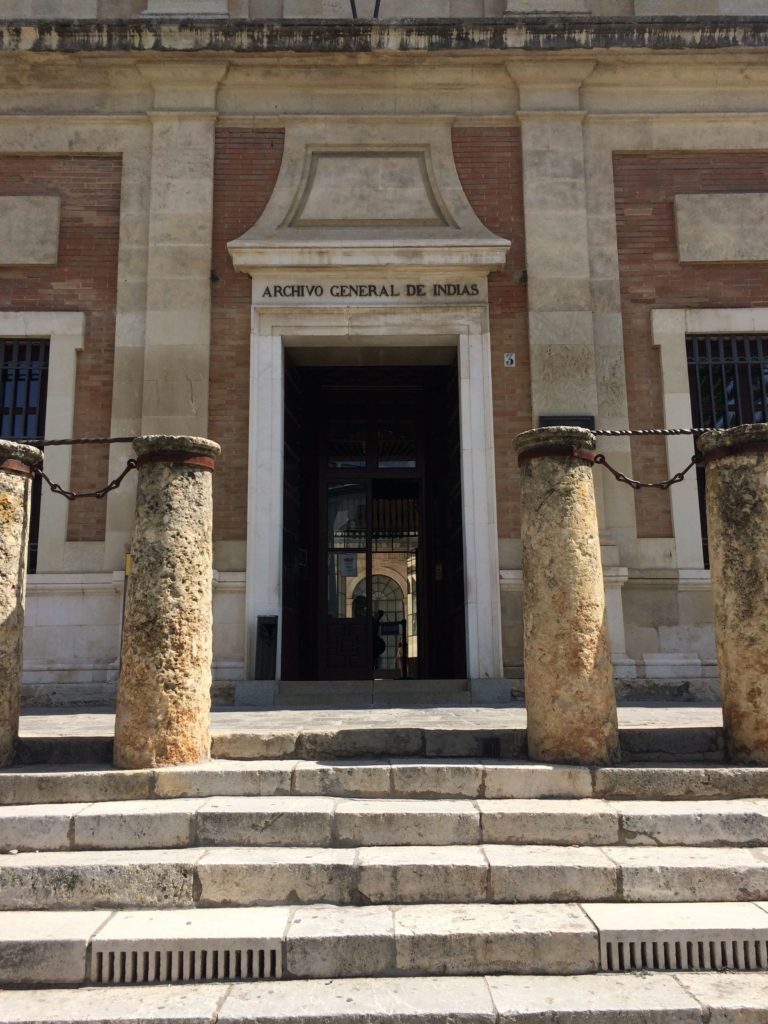
- A building literally full of history. The archive, which was founded in 1785, has collected more than 43 000 volumes, 80 million pages and around 8 000 maps about the Indies, that is the Americas (& the Philippines), covering the period 1492-1898. That is from the time America was discovered by Columbus until the loss of the last Spanish colony Cuba in 1898, in a war with the USA.
For the real history buff, there are Guided Tours of the Archive. A tour along priceless items & documents which tell the story about the discovery & colonisation of the Americas.
To learn more, click on: Archive of the Indies guided tour

Seville, visit to an open air museum
As with the other cities we visited in Spain, Seville is an open air museum. Besides the Cathedral, the Alcázar, the Archive & Tower of Gold, you pass many other beautiful historical buildings.
Near the river you’ll find several impressive mansions of the formerly richest families. Generally families that became wealthy because of the lucrative trade with the colonies. Close to the river you’ll find the famous Plaza de Toros or Bull Ring.
Officialy the Plaza de Toros de la Real Maestranza de Caballería de Sevilla, it’s one of most famous & biggest in the world. Daily tours of the Bullring & Museum will tell you all about its eventful history.
If interested, click on the following link: Guided Tour of the Seville Bullring
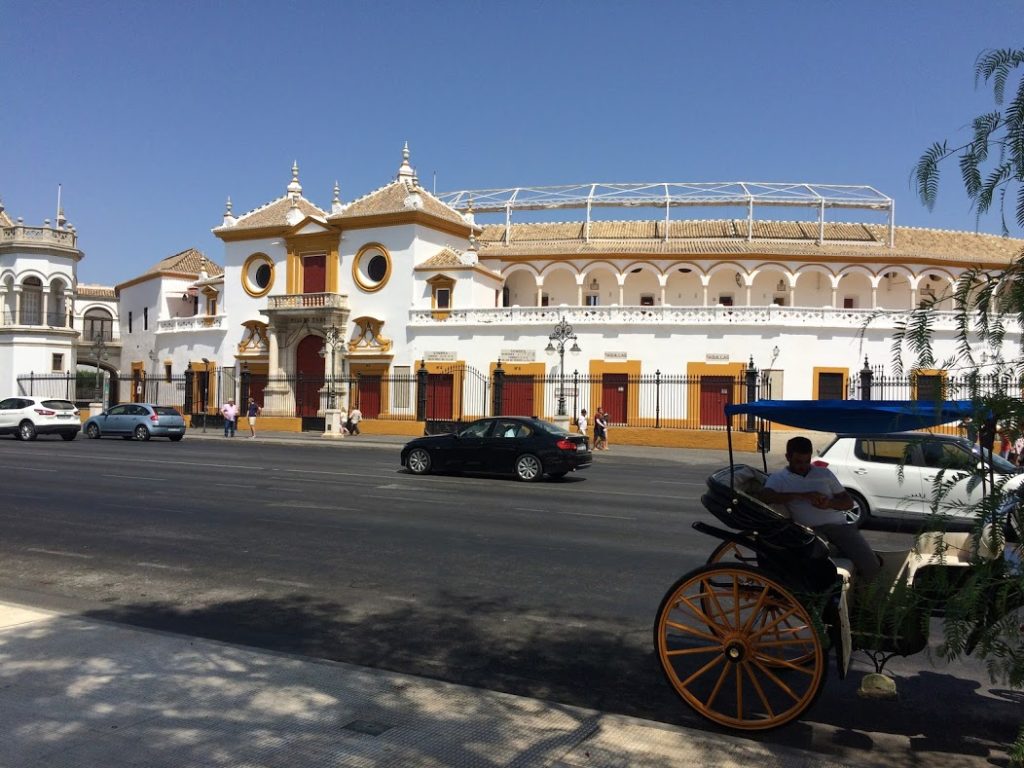
The Triana neighbourhood
The beautiful 19th century Isabella II Bridge, leads you to the bohemian neighbourhood of Triana (reason why most people call the mentioned bridge, the Puente de Triana).
This barrio was – and still is – a popular part of town. The neighbourhood where the fishermen lived, the artisans, the singers, the toreros or bullfighters, the flamenco dancers… but also the men that got hired to fill the ships that went to the colonies. A beautiful part of town to walk through, with the best fresh product market in town!
No surprise, Triana – as the birthplace of the flamenco performance – still offers the best show at the historical Teatro Flamenco Triana.
To learn more, go to: Triana Flamenco Show
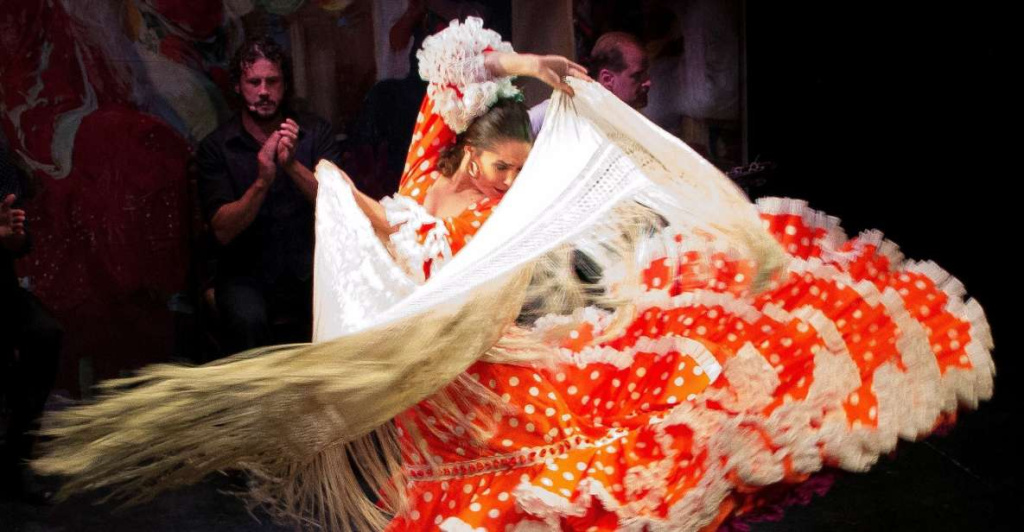
It is on this side of the river where you’ll also find the former headquarters of the infamous Spanish Inquisition, in the Castle of San Jorge (nowadays partially a museum).
Palacio de las Dueñas
Talking about Stately Seville: the Palacio de las Dueñas brings you back to the 15th Century when this palace was built. Representative of Seville as a whole. An Architectural Treasure in Renaissance style, mixed with Gothic & Moorish details.
- Although not built by them originally, the palace nowadays is (still) owned by the famous House of Alba. One of its members- Fernando Álvarez de Toledo y Pimentel, 3rd Duke of Alba (1507-1582) – was once the dreaded Governor of the Spanish Netherlands.

Open to the public as a museum since 2016 & one of the most visited in Seville.
To learn more, click on: Palacio de las Dueñas
Casa de Pilatos
Another Architectural Gem is the Casa de Pilatos. Also built in the 15th century. Basically in Renaissance style, but mixed with many Mudejár elements & impressive Art Works.
- This beautiful house – say Palace – belongs to the Dukes of Medinaceli.
Several times in the past the house was used as a film location, for movies like Lawrence of Arabia, 1492: Conquest of Paradise & Knight and Day (with Tom Cruise & Cameron Diaz).

To learn more, go to: Casa de Pilatos

Visit to the Plaza de España, Seville
By far the most popular square to visit in Seville is the Plaza de España. A colorful spot, formally part of the relaxing Maria Luisa Park.
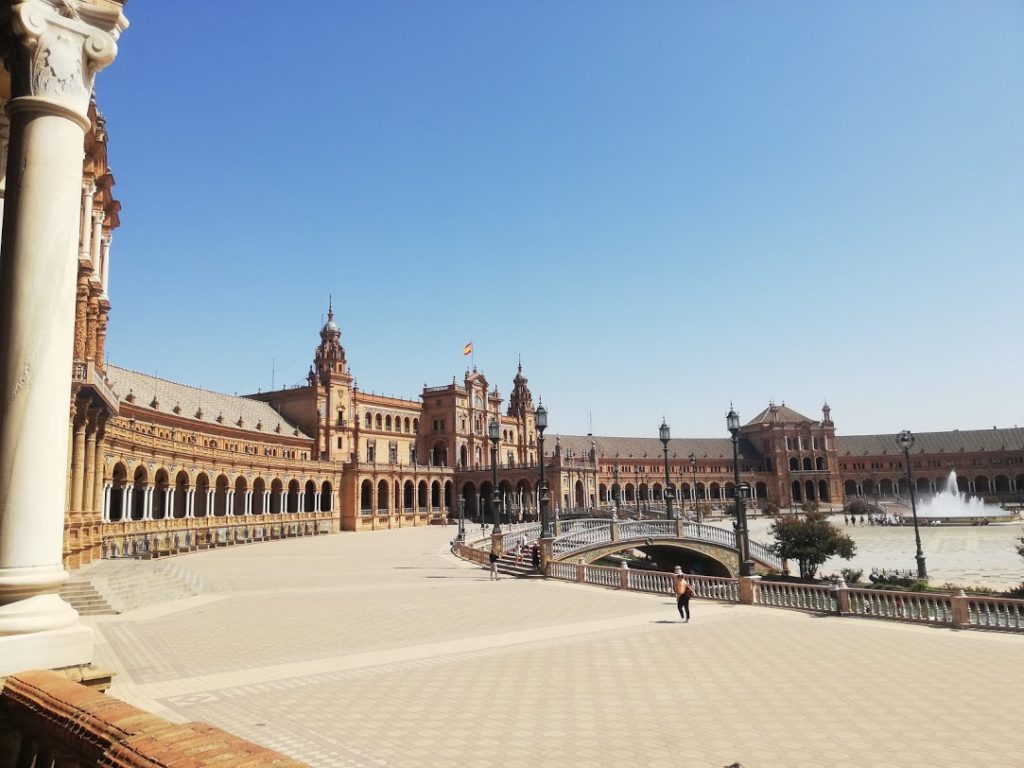
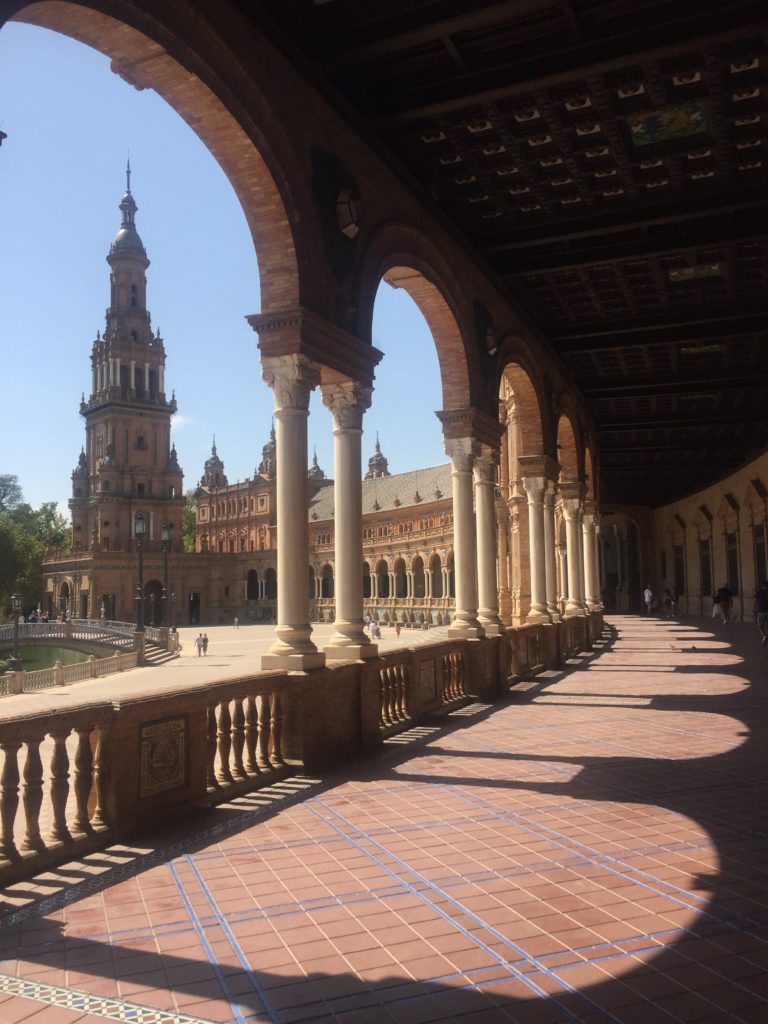
We ended up on the Plaza de España almost every evening. Principally to cool off at the big fountain in the center, but equally to admire the imposing pavilion building on one side of the plaza. Overwhelming Architecture, Art & Colors.
The semi-circle castle-like construction was built for the 1929 Ibero-American Exposition. The four main buildings represent the four ancient kingdoms. While the alcoves in front of the building represent every province of Spain through sceneries made of the typical tile-work you’ll find all over the country.
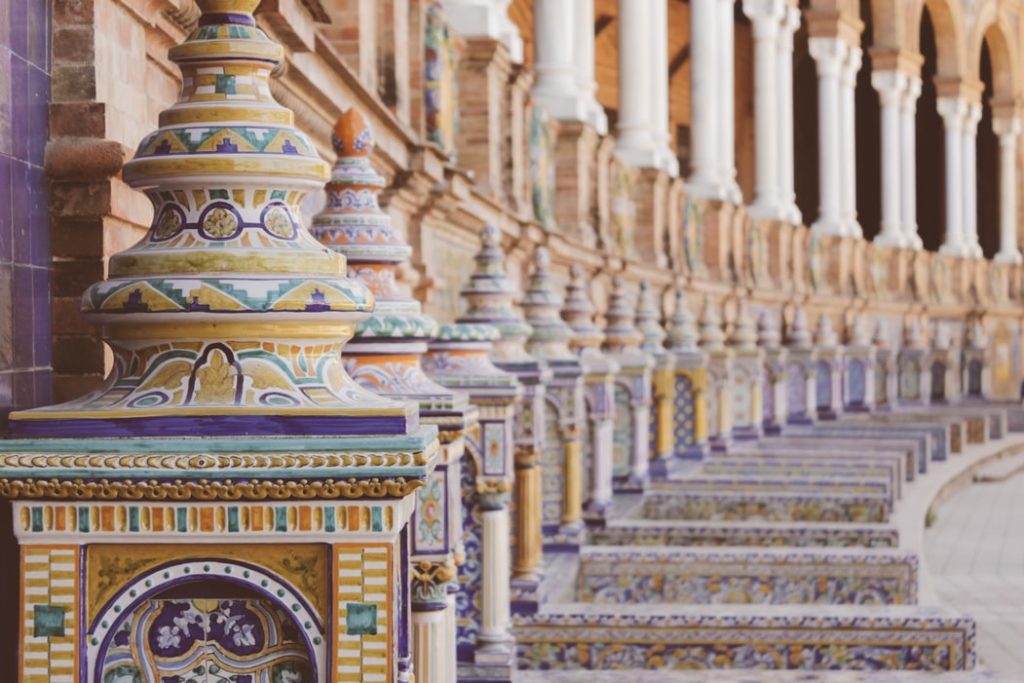
One evening we encountered a group of flamenco artists performing on the square. Impressive to say the least. Music & dance which represents the long history & local culture of Andalusia, Spain.
TRAVELTip: A visit to the Plaza de España is included in most walking or bike tours of the city center of Seville (see segment on Getting Around in Seville). Besides that, it’s a spot where many visitors shoot pictures. Of the monumental surroundings & of themselves.
No surprise then, you can organise a professional photo shoot on the Plaza if you like.
To learn more, click on: Plaza de España Photo Shoot
Metropol Parasol
We visited the Metropol Parasol daily. Mainly because our lodgings were nearby. Every time finding a reason to stop there for a while. Not only for its architectural beauty, but also to admire the play of shadows it provides for the visitors below.
Many locals call the Metropol Parasol the Setas de Sevilla/ Seville Mushrooms. A unique piece of modern architecture.
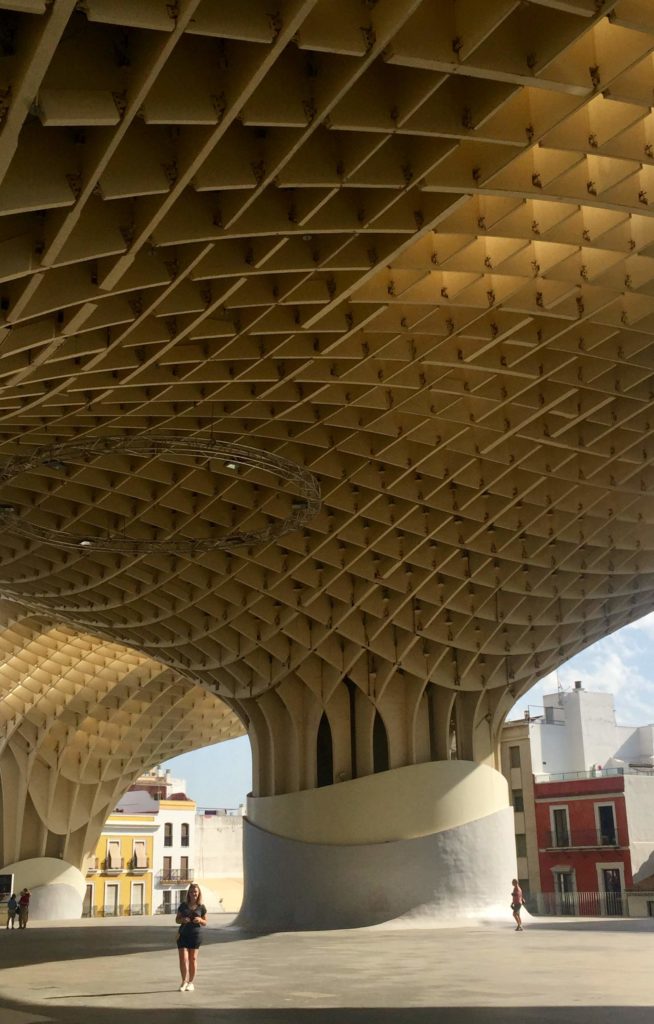
From the rooftop you’ve spectacular views of the city. A unique spot, you can visit on a tour of this unique Parasol, learning about Seville’s long, eventful history.
To learn more, go to: Las Setas Guided Tour
Boat ride on the Guadalquivir
One of the last days we decided for a Boat ride on the Río Guadalquivir. One reason was to claim my place on the river, but also to escape the heat for a while. Just to sit down, relax & enjoy the historical attractions you pass along the river between El Arenal & the Triana neighbourhoods.

To learn more, go to: Guadalquivir Boat Ride

Cooking classes, food tours, the best tapas & others…
In Seville you can participate in several unique, popular, but also interesting food tours and/or cooking classes.
Click on their names, to learn more:
- Tapas crawl (an entertaining evening touring the best tapa bars of Seville, 3 hours)
- Spanish Cooking Class (learn to prepare local dishes at the Triana Market, including a diner, 3 hours)
- Paella Cooking Experience (watch an expert at work enjoying 360° views of the city center, 2 – 2,5 hours)
- Triana Market Tour & Cooking Class (prepare & taste Andalusian dishes with fresh ingredients bought from the best & most beautiful market in Seville, 3 hours)
- Sangria Tasting with Rooftop Views (learn about the history & preparation of 4 types of sangria, 1,5 hours)

Popular day-trips from Seville
When staying in Seville longer than 2 or 3 days there’s the option to go on a day-trip to explore popular outdoor attractions nearby. There are more organised day tours from Seville than from any other place in Andalusia, like Granada & Malaga.
Pueblos Blancos & Ronda Day Trip
- One of the most popular day-trips from Seville is a Guided Tour of the White Villages & the Old Town of La Ronda. A full day-trip (10 hours) in which you learn & experience the region’s interesting history & local culture in an amazingly beautiful natural environment.

To learn more about this tour, click on: Pueblos Blancos and Ronda Full-Day Trip
A visit to the Alhambra & Albayzín in Granada
- If you haven’t included Granada in your itinerary, there’s the option to visit the worldfamous Alhambra & the Moorish neighbourhood of Albayzín on a full day-trip (13 hours) from Seville. Including a professional guide who can tell you all about both fascinating attractions.

To learn more about this long, but unforgettable day-trip, click on: Day-trip to the Alhambra & Albayzín
Day-trip to Córdoba, including the Mosque-Cathedral
- Another historical monument which perplexed us during our journey through Spain was the Mosque-Cathedral in Córdoba (10 hours). A MUST VISIT when in Andalusia, besides Alhambra in Granada, the Alcázar of Seville & the Sagrada Familia in Barcelona.
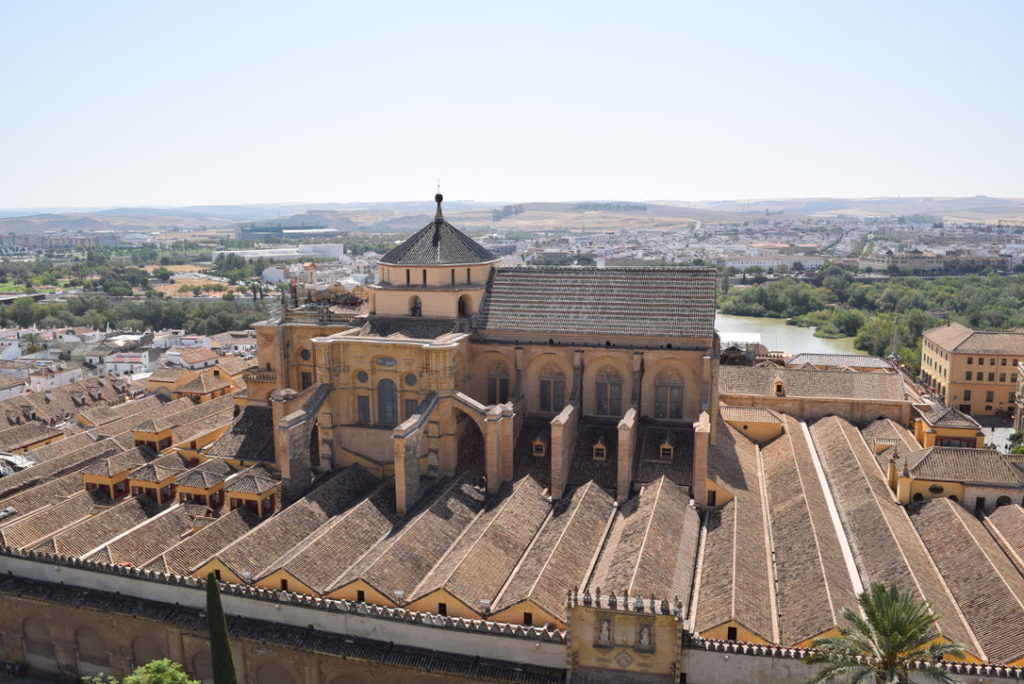
- The oldest foundations of the mosque go back to the 8th century. Not long after the Moors had invaded Spain from Africa. Little by little, century by century the mosque got bigger and bigger, until the Iberians reconquered Córdoba definitely in 1236.
- Instead of tearing the whole place down though, the Iberians converted the mosque into a catholic church, later on becoming a cathedral.
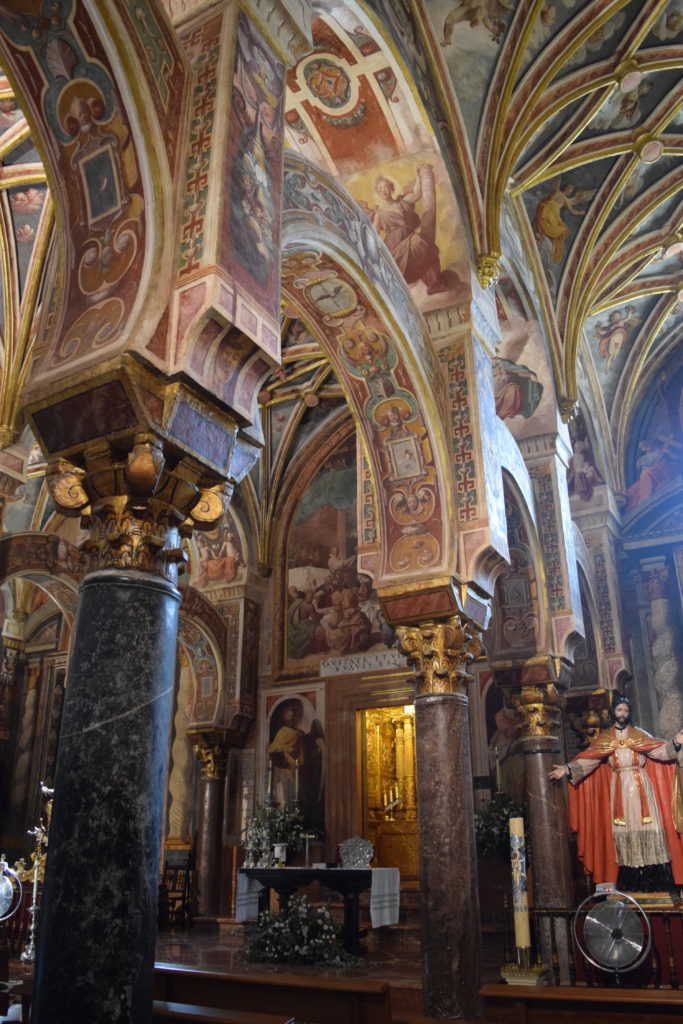
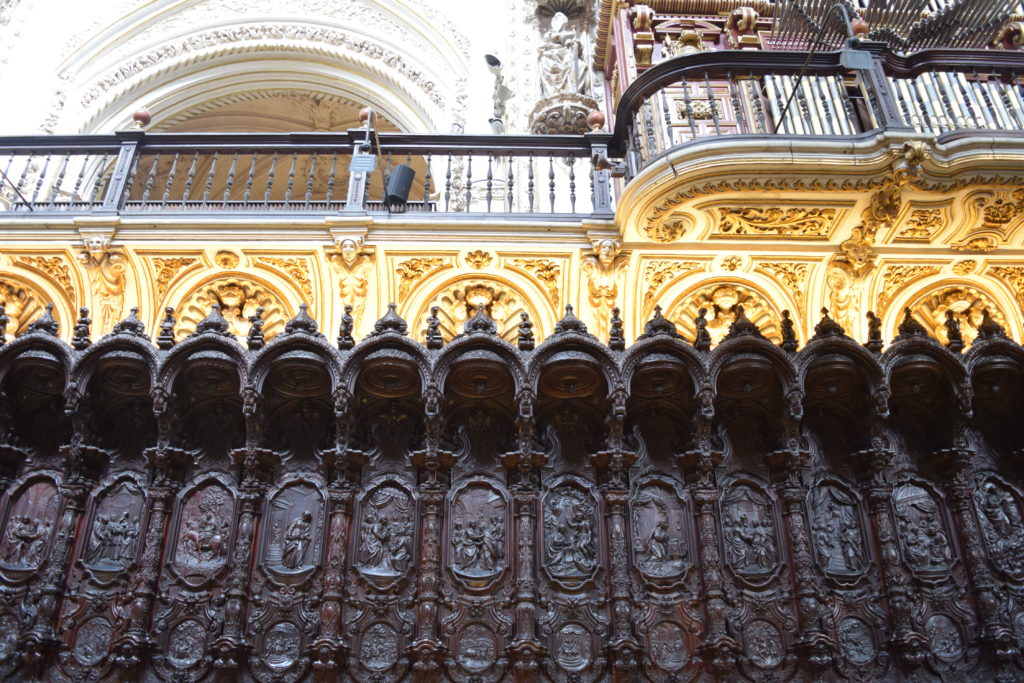
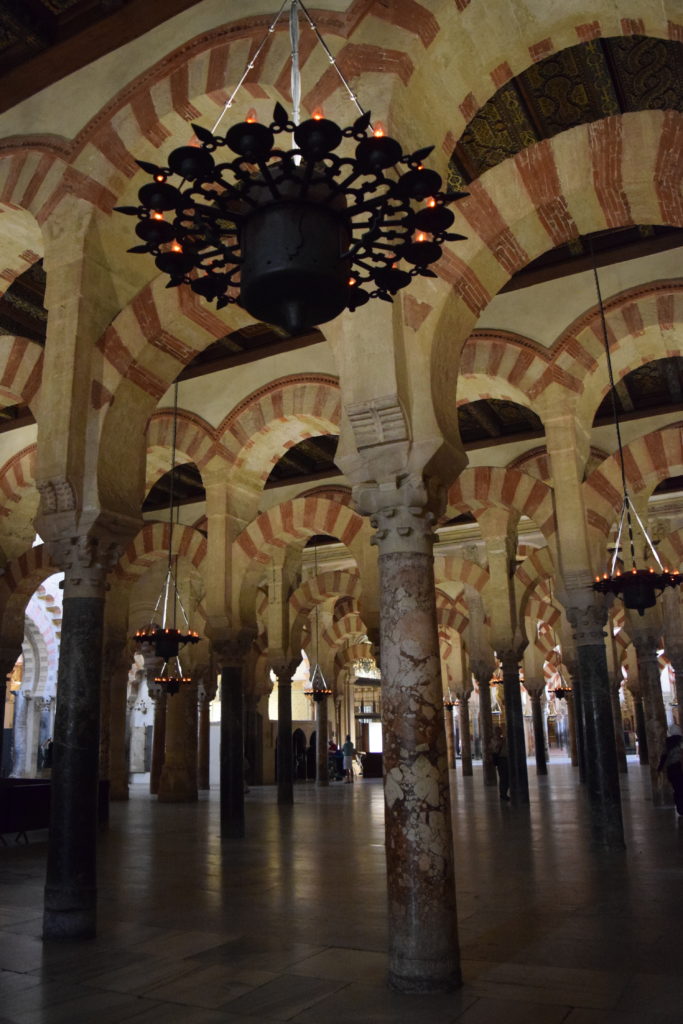
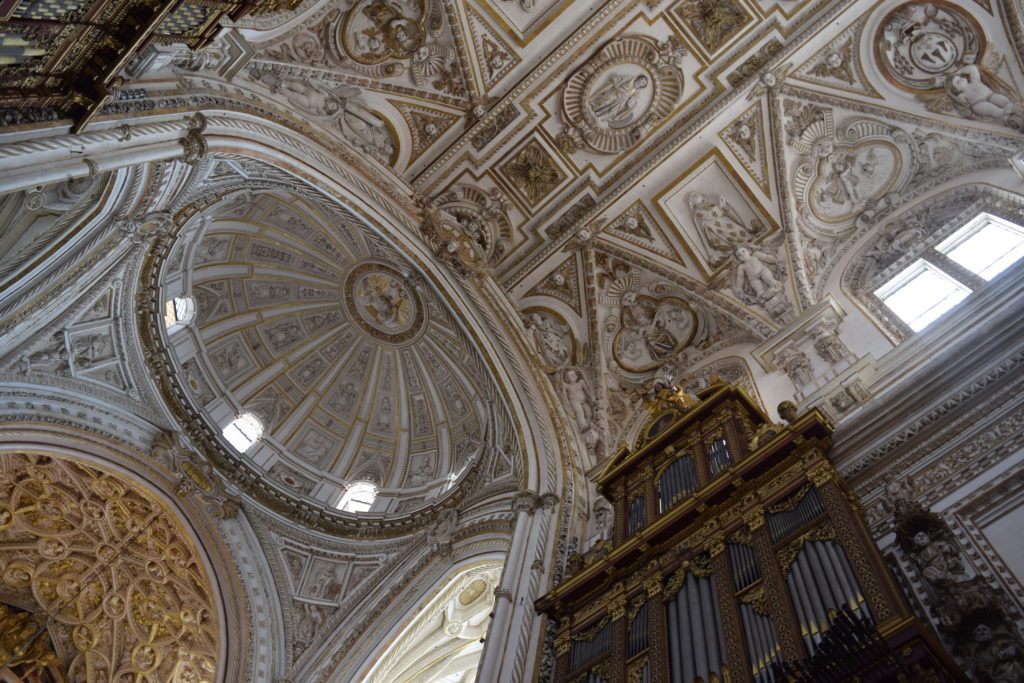
To learn more, click on: Córdoba day-trip from Seville
From Seville: El Caminito del Rey
- A popular outdoor activity near Seville is the Caminito del Rey Hike (10 hours). In one of the most scenic nature parks Andalusia has to offer. An adventurous hike over century-old narrow – but safe! – walking trails & suspension bridges along deep gorges with jade-green rivers below.

To learn more, go to: Day-trip to the Caminito del Rey
The Doñana National Park
- To the Southwest of Seville – heading to the Atlantic Ocean – is located El Parque Nacional de Doñano. A unique park because of its wetlands, migratory birds (like flamingos & eagles), small mammals (lynx, otters & deer), pine forests, shifting coastal sand dunes & pristine beaches.
- All to admire during a full-day Tour of the Doñana National Park (10 hours).

To learn more about this Nature Experience, go to: Day-trip to the Doñana National Park
Half-a-day Tour of the Roman city of Italica
- Nearer to Seville you can visit the birthplace of the Roman Emperors Trajan & Hadrian on a half-day trip (4 hours): Guided Tour of the Roman City Italica.
- Still impressively Imperial, among other things because of the presence of one of the largests Roman amphitheaters in Europe (used as a filiming location for the Game of Thrones series).

To learn more, click on: Tour of Italica
Alternatively, you can make this historical visit also on a fun: Guided EBike Tour to the Roman ruins of Italica.
A visit to the Rock of Gibraltar
- Finally, you can cross over to the UK on a full-day (11 hours) Tour to the Rock of Gibraltar. With impressive looks of Africa across the Strait. Or you can set of Seville on a 15 hour Day-Trip to Tangier, Morocco. Crossing over to have of view of Gibraltar, Spain & Europe from the African coast.
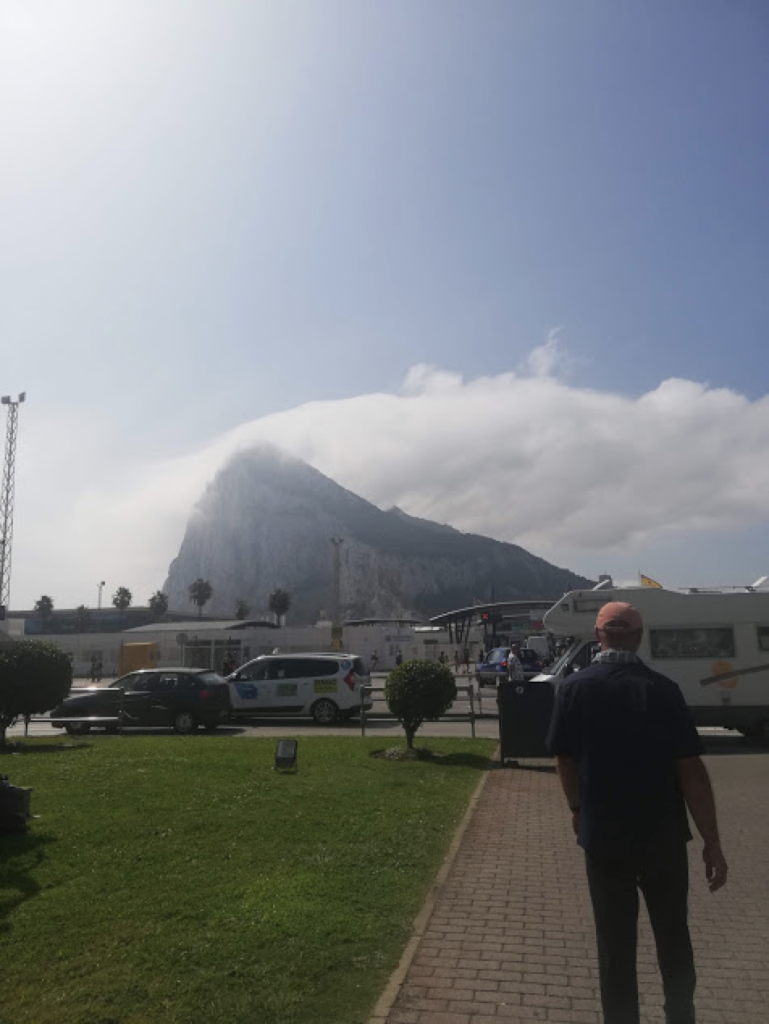
My first impression was that the rock was actually bigger than I had thought beforehand.
A sight, I will never forget.

To learn about this tour from Seville, go to: Day-trip to Gibraltar
Visit Seville as a Family
Personally I think many of the attractions & tours I’ve treated so far lent themselves perfectly for your children also.
But of course, there are always other ones that are generally more popular for them. Special activities which may help you vary the Things to do in Seville a little. Between interesting, entertaining & fun.
I’ve made a small selective of things you can visit or undertake when visiting Seville with your children.
Click on their names to learn more about:
- A visit to The Isla Mágica Theme Park

To put our visit to Seville in a few words:
Seville is a beautiful place to visit, an essential part of the mystery of Andalusia.
Comparing the city to Granada, I would say that Seville is bigger, more modern, more a capital, more chic & for that reason missing that little historic mystery that hangs over Granada still.
However, because of its size & the heat, we didn’t visit every part. Surely there are many spots left for us to visit in the future. I am mainly thinking of Triana for example, or following the Guadalquivir river downstream.
Personally I think Seville’s Alcázar, together with Granada’s Alhambra & Córdoba’s Mosque-Cathedral (see below) were the architectural highlights of our first acquaintance with Andalusia. A fact shared by many who visited this part of Spain before us.
And finally,… to put our journey through to Spain in a few words:
Spain. What an amazing country. Really. The diversity, its history, the architecture, the local culure, the food & the people. We enjoyed everything.
Concerning the main attractions in Spain, I would place the Alhambra in Granada first, but also tremendously enjoyed the Royal Chapel in the same city. As well as the Alcázar of Seville, the Sagrada Familia in Barcelona, the Xàtiva castle near Valencia and the Mosque-Cathedral in Córdoba.
Thank you, Spain. Muchas gracias. We’ll be back… soon!
For an overview of all travel posts of my blog, go to: the Home Page.


